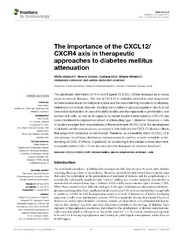Приказ основних података о документу
The Importance of the CXCL12/CXCR4 Axis in Therapeutic Approaches to Diabetes Mellitus Attenuation
| dc.creator | Vidaković, Melita | |
| dc.creator | Grdović, Nevena | |
| dc.creator | Dinić, Svetlana | |
| dc.creator | Mihailović, Mirjana | |
| dc.creator | Uskoković, Aleksandra | |
| dc.creator | Arambašić Jovanović, Jelena | |
| dc.date.accessioned | 2017-11-23T11:27:13Z | |
| dc.date.available | 2017-11-23T11:27:13Z | |
| dc.date.issued | 2015 | |
| dc.identifier.issn | 1664-3224 | |
| dc.identifier.uri | http://www.pubmedcentral.nih.gov/articlerender.fcgi?artid=PMC4528295 | |
| dc.identifier.uri | https://radar.ibiss.bg.ac.rs/handle/123456789/2678 | |
| dc.identifier.uri | http://journal.frontiersin.org/article/10.3389/fimmu.2015.00403/full# | |
| dc.description.abstract | The pleiotropic chemokine (C-X-C motif) ligand 12 (CXCL12) has emerged as a crucial player in several diseases. The role of CXCL12 in diabetes promotion and progression remains elusive due to its multiple functions and the overwhelming complexity of diabetes. Diabetes is a metabolic disorder resulting from a failure in glucose regulation due to β-cell loss and/or dysfunction. In view of its ability to stimulate the regeneration, proliferation, and survival of β-cells, as well as its capacity to sustain local immune-isolation, CXCL12 has been considered in approaches aimed at attenuating type 1 diabetes. However, a note of caution emerges from examinations of the involvement of CXCL12 in the development of diabetes and its complications, as research data indicate that CXCL12 displays effects that range from protective to detrimental. Therefore, as a beneficial effect of CXCL12 in one process could have deleterious consequences in another, a more complete understanding of CXCL12 effects, in particular its functioning in the cellular microenvironment, is essential before CXCL12 can be considered in therapies for diabetes treatment. | en |
| dc.relation | info:eu-repo/grantAgreement/MESTD/Basic Research (BR or ON)/173020/RS// | |
| dc.relation | COST Action CM1406 | |
| dc.rights | openAccess | |
| dc.rights.uri | https://creativecommons.org/licenses/by/4.0/ | |
| dc.source | Frontiers in immunology | |
| dc.subject | CXCL12 | |
| dc.subject | CXCR4 | |
| dc.subject | CXCR7 | |
| dc.subject | Diabetes mellitus | |
| dc.subject | Diabetic complications | |
| dc.subject | Pancreatic β-cells | |
| dc.title | The Importance of the CXCL12/CXCR4 Axis in Therapeutic Approaches to Diabetes Mellitus Attenuation | en |
| dc.type | article | |
| dc.rights.license | BY | |
| dcterms.abstract | Михаиловић, Мирјана; Ускоковић, Aлександра; Динић, Светлана; Видаковић, Мелита; Aрамбашић Јовановић, Јелена; Грдовић, Невена; | |
| dc.rights.holder | © 2015 Authors | |
| dc.citation.volume | 6 | |
| dc.identifier.doi | 10.3389/fimmu.2015.00403 | |
| dc.identifier.pmid | 26300887 | |
| dc.identifier.scopus | 2-s2.0-84938502153 | |
| dc.identifier.wos | 000359470600002 | |
| dc.citation.apa | Vidaković, M., Grdović, N., Dinić, S., Mihailović, M., Uskoković, A., & Arambašić Jovanović, J. (2015). The Importance of the CXCL12/CXCR4 Axis in Therapeutic Approaches to Diabetes Mellitus Attenuation. Frontiers in immunology, 6, 403. | |
| dc.citation.vancouver | Vidaković M, Grdović N, Dinić S, Mihailović M, Uskoković A, Arambašić Jovanović J. The Importance of the CXCL12/CXCR4 Axis in Therapeutic Approaches to Diabetes Mellitus Attenuation. Front Immunol. 2015;6:403. | |
| dc.citation.spage | 403 | |
| dc.citation.epage | 403 | |
| dc.type.version | publishedVersion | en |
| dc.identifier.fulltext | https://radar.ibiss.bg.ac.rs//bitstream/id/3249/FrontImmunol_2015_6_403.pdf | |
| dc.citation.rank | M14 |

